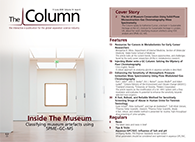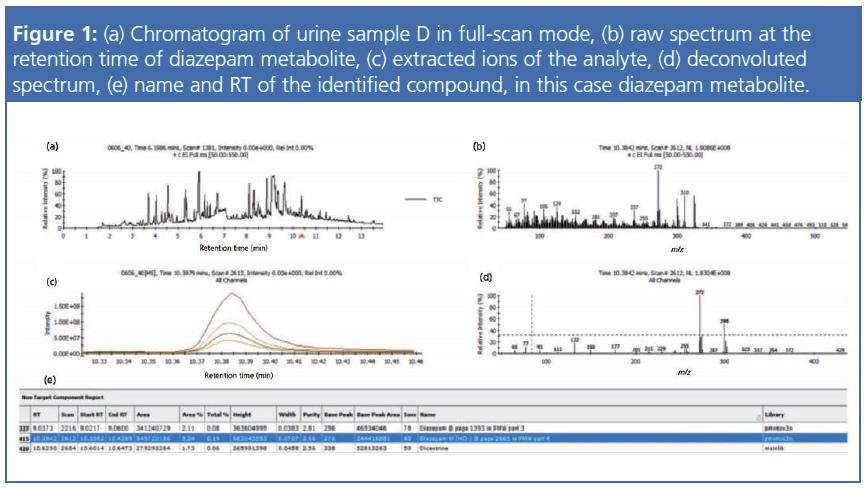The Art of Museum Conservation Using Solid-Phase Microextraction–Gas Chromatography–Mass Spectrometry
The Column spoke to Katherine Curran, a lecturer in Sustainable Heritage at the UCL Institute for Sustainable Heritage in London, UK, about her work classifying museum artefacts using volatile organic compound (VOC) analysis and solid-phase microextraction–gas chromatography–mass spectrometry (SPME–GC–MS).
Photo Credit: Hunter Bliss/ Shutterstock.com

The Column spoke to Katherine Curran, a lecturer in Sustainable Heritage at the UCL Institute for Sustainable Heritage in London, UK, about her work classifying museum artefacts using volatile organic compound (VOC) analysis and solid-phase microextraction–gas chromatography–mass spectrometry (SPME–GC–MS). - Interview by Kate Mosford
Q. Your group has been classifying polymeric museum artefacts using volatile organic compound (VOC) analysis and solid-phase microextraction–gas chromatography–mass spectrometry (SPME–GC–MS) (1). What led your group to begin this study?
A: We know that analysis of VOCs is a very powerful technique that has been widely researched for medical applications. Many of the features that make it useful in medicine are extremely relevant to heritage, such as the fact that VOC analysis is noninvasive and that you can obtain useful information, such as the diagnosis of a particular disease, by analyzing complex mixtures of components. These are both really important features when working with museum artefacts because the more you can make your analysis noninvasive the better. Museum artefacts are also really complex, so a technique that can deal with this complexity is very useful in this context also.
There had been some previous work in our research group on the study of VOCs from a historic paper and it was shown that VOC emissions could be linked to material properties and material degradation (2). The conservation of plastics in museum collections is a much less advanced field than the conservation of older materials such as paper, stone, or wood. However, plastics in museums can be some of the most fragile materials present, and some of the earliest and most experimental plastics are now in museums. Some of these have been found to degrade quite rapidly and dramatically. So there is a lot of research needed to understand degradation processes and how best to conserve such objects.
Bringing all of this together, we felt that using VOC analysis could provide an important insight into the degradation of polymeric museum artefacts such as plastics, identifying evidence of degradation while acting as a noninvasive method.
Q. What kind of polymeric artefacts have you investigated?
A: At Tate in London we analyzed three sculptures, made of either cellulose acetate or cellulose nitrate, two of the earliest and most problematic plastics found in museum collections. These were works by the artists Naum Gabo and Antoine Pevsner.
In the laboratory, we analyzed over 200 objects. These were chosen to include the types of polymers that are known to be found in museum and archive collections and comprised combs and accessories
from around the 1930s, vinyl records, plastic toys, jewellery, crockery, and some newly produced polymer samples.
Q. Can you tell us about the chromatographic method you chose for this research and why?
A: We used SPME–GC–MS. SPME was developed in the early 1990s by Janusz Pawliszyn from the University of Waterloo in Ontario, Canada. We used it for analysis of VOCs in the headspace of our objects. It uses a fibre with an adsorbent coating to collect VOCs from the headspace, which are then desorbed in the injector port of the GC–MS system.
We chose it because it is straightforward to use and can be used noninvasively for direct analysis of artefacts on-site in the museum stores or galleries.
Q. Were there any particular precautions that had to be undertaken when analyzing these valuable artefacts?
A: This was all done with the support of collaborators at Tate. We worked with Joyce Townsend, who is a Senior Conservation Scientist, and Deborah Cane, who is a Conservation Manager. They needed to be present when we placed the SPME fibres in the cases with the artefacts to supervise our work. SPME–GC–MS is a very noninvasive technique, so all we needed to do was place the fibre alongside the object and leave it in place for 1 week. Photos of this can be seen in the paper (1).
Q. What is novel about your approach or findings?
A: No one has used VOC analysis to understand the degradation of plastic museum objects before. There has been research on the characteristic VOCs that certain types of plastic artefacts emit, but our approach looks at how you can use statistical analysis to identify mixtures of VOCs that indicate degradation. This builds on previous research in medicine where mixtures of VOCs are used for disease diagnosis.
Q. Can steps be put in place to halt polymer degradation in museum artefacts?
A: At present, the best approaches are to control the environment in which artefacts are stored or displayed. For plastics, some objects are put in cold storage to slow down the rates of chemical degradation. In many museums, relative humidity is also controlled so that chemical reactions based on hydrolysis are inhibited. Some of the problematic plastics emit acids as they break down, which can accelerate deterioration and have an effect on other objects. Therefore, some museums put absorbents in museum storage containers to absorb these acids. However, it’s not always clear that these methods are useful for all objects, and more research needs to be done to identify when such measures are helpful and when they are not.
There has also been very little research done on the best way to clean or treat damaged plastic museum objects. There is research going on to develop nanomaterials for conservation of contemporary art works, as part of a big European project called Nanorestart: http://www.nanorestart.eu/
Q. What other chromatographic techniques have you used for museum conservation?
A: We use gel permeation chromatography (GPC) to identify the molecular weight of polymeric materials. In general, chromatography is hugely important in museum conservation. There is a conference dedicated to it called MaSC “Users’ Group for Mass Spectrometry and Chromatography”: https://mascgroup.org/. People use pyrolysis (Py-GC–MS), GC–MS, liquid chromatography (LC)–MS, high performance liquid chromatography (HPLC), and many other techniques for identifying the components of complex mixtures, such as in historic paints.
References
- K. Curran et al., Angew Chem. Int. Ed. Engl. Feb 5 (2018).
- M. Strlic, J. Thomas, T. Trafela, L. Csefalvayova, I. Kralj Cigic, J. Kolar, and M. Cassar, Anal. Chem. 81, 8617–8622 (2009).

Katherine Curran has worked as a Lecturer in Sustainable Heritage at the UCL Institute for Sustainable Heritage since 2013. She is Assistant Course Director for the MSc in Sustainable Heritage and the Principal Investigator for the ERC Starting Grant funded project “COMPLEX: The Degradation of Complex Modern Polymeric Objects in Heritage Collections: A System Dynamics Approach” which will develop new approaches to understanding and modelling the degradation of modern polymeric materials in collections.
Katherine joined the Institute for Sustainable Heritage as a Research Associate in November 2011, to work on the AHRC/EPSRC Science & Heritage Programme project “Heritage Smells”.
From 2010–2011, Katherine received a Fulbright Scholarship from the Fulbright Commission in Ireland and worked with Jeffrey Moore at the University of Illinois in UrbanaâChampaign, USA, on the synthesis of macrocyclic compounds via alkyne metathesis.
Katherine obtained her Ph.D. in polymer chemistry (“Pd(II)- and Zr(IV)-catalysed Olefin Addition Polymerisation of Cyclobutene-based Monomers”) in 2009 from University College Dublin (UCD), Ireland, and her B.Sc. (chemistry) in 2004, also from UCD.
E-mail:k.curran@ucl.ac.ukWebsite:www.ucl.ac.uk/bartlett/heritage/

Common Challenges in Nitrosamine Analysis: An LCGC International Peer Exchange
April 15th 2025A recent roundtable discussion featuring Aloka Srinivasan of Raaha, Mayank Bhanti of the United States Pharmacopeia (USP), and Amber Burch of Purisys discussed the challenges surrounding nitrosamine analysis in pharmaceuticals.
Silvia Radenkovic on Building Connections in the Scientific Community
April 11th 2025In the second part of our conversation with Silvia Radenkovic, she shares insights into her involvement in scientific organizations and offers advice for young scientists looking to engage more in scientific organizations.

.png&w=3840&q=75)

.png&w=3840&q=75)



.png&w=3840&q=75)



.png&w=3840&q=75)










